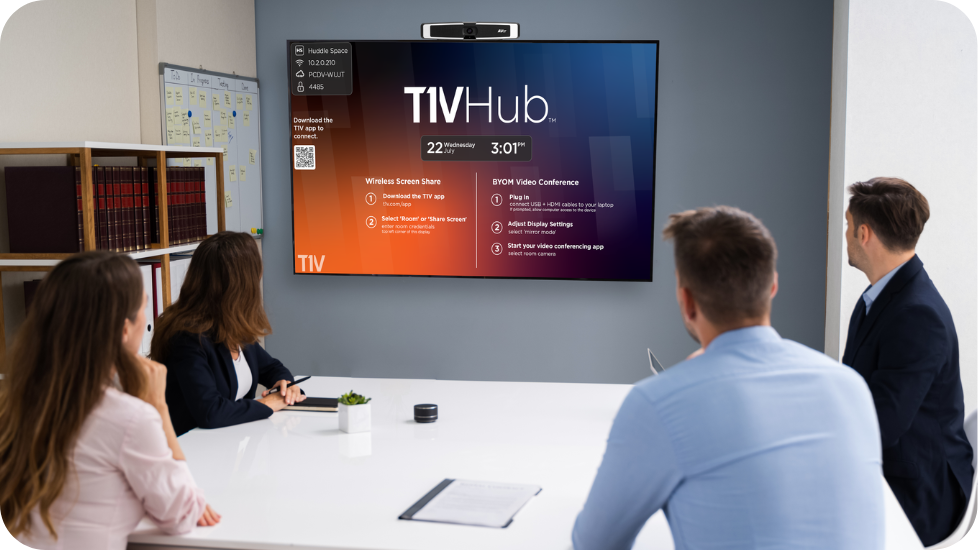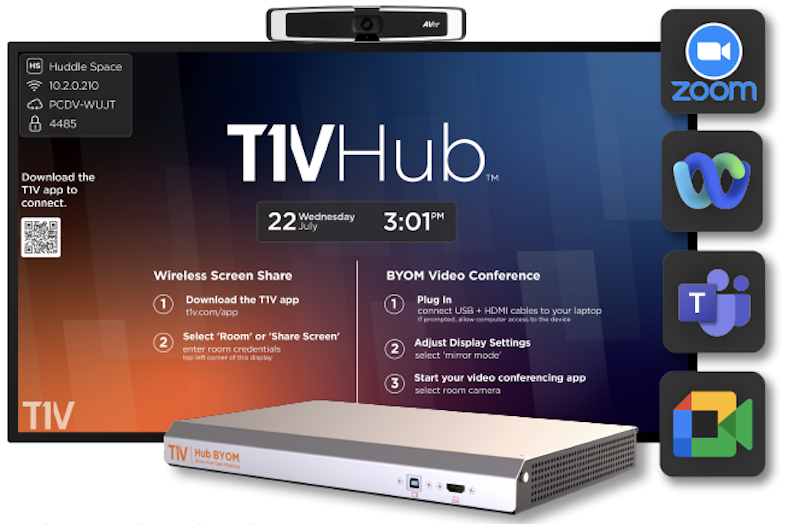Room-Based Meetings (RBM) vs. Bring Your Own Meeting (BYOM). Which solution is right for your organization?
Before we get to that, let’s start by defining what these two terms mean, and who the major players are:
What is a Room-Based Meeting (RBM)?
A Room-Based Meeting (RBM) relies on a dedicated in-room system to drive meeting technology.
A typical RBM setup includes:
- Shared in-room display (touch or non-touch)
- Video bar setup: camera, microphone, speakers
- Collaboration tool that is used to run the collaboration and/or video conferencing software in the room
In this scenario, meeting participants have the option to bring their own device (BYOD) as a means to share content, but it is not required to initiate and run the meeting software.
Here are some key attributes of an RBM:
- Single tap to start
- Easy to use (intuitive UI/UX)
- Participant’s device is not tied up doing video conferencing
- Don't need a device to video conference (use the RBM system to run VC)
- RBM system distributes content
- More conducive to large deployments
Here are some of the key players providing RBM solutions:
In this lineup of contenders, the most notable differentiators for both Hub and ThinkHub are:
- Use whatever video conferencing flavor you want (total interoperability - run Zoom, Webex, MS Teams, or Google Meet)
- Supports multiple, simultaneous content streams, from multiple participants (Hub can share up to four BYOD devices (QuadCast) at a time; ThinkHub can share unlimited BYOD devices)
What is Bring Your Own Meeting (BYOM)?
A Bring Your Own Meeting (BYOM) relies on a meeting participant’s device to drive the meeting technology.
The typical BYOM setup includes:
- Shared in-room display (touch or non-touch)
- Video bar setup: camera, microphone, speakers
- An appliance that supports screen mirroring from the participant device to the shared in-room display
- Participant’s BYOD device running the video conferencing software
In this scenario, meeting participants bring their own device (BYOD) to share their device screen AND to initiate and run the meeting software. The participant’s device is dedicated to running the meeting.
Here are some key attributes of BYOM:
- Uses apps on your device you hopefully know well
- IT pushes video conferencing upgrades to device user to manage
- Device cannot be used for anything during call
- All set up for AV in meeting room is on the user
- Device user owns distribution of content
- More conducive to smaller orgs with power users
Here are some of the key players providing BYOM solutions:
- T1V Hub BYOM
- Windows Collaboration Display (WCD)
- Barco Clickshare Conference
- Crestron Mercury
- Huddle Hub
- Mersive
Out of all these BYOM solutions, T1V Hub BYOM stands out for numerous reasons:
- It’s simple technology – all you have to do is plug in your own device to start video conferencing
- Flexibility to plug in your device or connect it wirelessly – plus, it works across major OS: Apple, iOS, Windows, and Android
- Total interoperability across your favorite and most-used video conferencing applications (Zoom, Webex, MS Teams, or Google Meet)

Key Takeaways
To summarize, depending on your workplace environment — both meeting solutions are excellent options to support your hybrid teams.
Room-Based Meeting (RBM) is a great solution for creating a more standardized workplace. The technology is typically intuitive and easy to use for the novice user which means any person who walks into the room should be able to tap and go or connect wirelessly from a remote location without major training required on how to use the software. For the meeting organizer or any of the participants (whether in-room or connecting remotely) — BYOD devices are not required to run the meeting, so while participants can share content, they are still able to do things like check email / take notes without it being mirrored on the shared display.
When looking at Bring Your Own Meeting (BYOM) solutions, be mindful that these solutions tend to put more onus on the end user – meaning it’s their responsibility to know the software on their device required to run the meeting. That said, it often gives users flexibility to choose the software they wish to use and how they wish to share it Plus, it can be easier on IT departments to maintain.
To better understand how your team can benefit from ThinkHub visual collaboration software and Hub BYOM – and which solution is best for your hybrid teams and spaces – book a demo with a member of our team today. 
FAQ
Q: What are the potential drawbacks or challenges associated with each approach that are not addressed in the article?
A: While RBM may offer simplicity and standardization, it might lack the flexibility to accommodate diverse meeting formats or technological preferences. Similarly, while BYOM empowers users with flexibility and control, there could be concerns regarding security, compatibility issues, or user training requirements.
Q: How do RBM and BYOM solutions align with different organizational needs or contexts?
A: Factors that organizations should consider when deciding between RBM and BYOM are team size, collaboration requirements, budget constraints, or existing technological infrastructure.